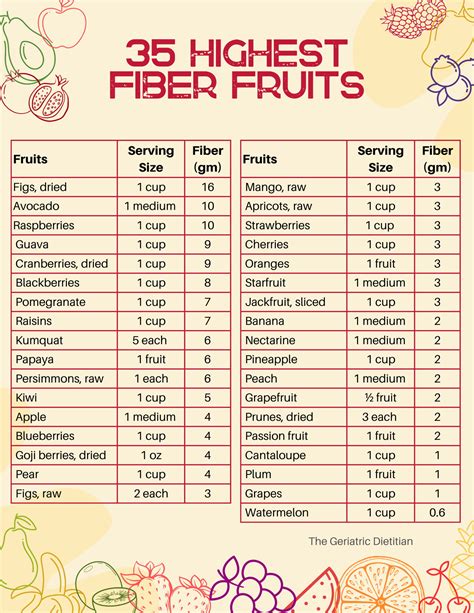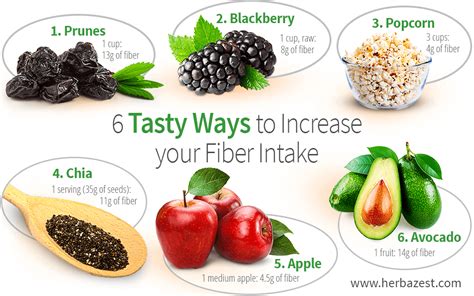Intro
Discover fruits high in fiber, including berries, apples, and bananas, rich in dietary fiber, promoting digestive health, satiety, and healthy blood sugar levels, supporting a balanced diet.
The importance of fiber in our diet cannot be overstated. Fiber plays a crucial role in maintaining a healthy digestive system, promoting satiety, and supporting healthy blood sugar levels. One of the best ways to increase our fiber intake is by consuming fruits that are high in fiber. Fruits are not only delicious, but they are also packed with essential vitamins, minerals, and antioxidants that can help protect against chronic diseases. In this article, we will explore the benefits of consuming fruits high in fiber and provide a list of the top fruits that can help you meet your daily fiber needs.
A diet rich in fiber can have numerous health benefits, including promoting regular bowel movements, preventing constipation, and supporting healthy gut bacteria. Fiber can also help lower cholesterol levels, reduce inflammation, and improve blood sugar control. The daily recommended intake of fiber is 25-30 grams per day, but many of us fall short of this target. Incorporating fruits high in fiber into our diet can help bridge this gap and provide numerous health benefits. With so many delicious and nutritious options available, it's easy to get started on a high-fiber diet.
Fruits are an excellent source of dietary fiber, and there are many varieties to choose from. From apples and bananas to berries and citrus fruits, there's a fruit to suit every taste and preference. In addition to their high fiber content, fruits are also rich in vitamins, minerals, and antioxidants that can help protect against chronic diseases such as heart disease, diabetes, and certain types of cancer. By incorporating a variety of fruits into our diet, we can reap the rewards of a healthy and balanced diet.
Fruits High In Fiber

Some of the top fruits high in fiber include apples, bananas, and berries. These fruits are not only delicious, but they are also rich in fiber, vitamins, and minerals. Apples, for example, contain both soluble and insoluble fiber, making them an excellent choice for promoting digestive health. Bananas are a good source of pectin, a type of soluble fiber that can help lower cholesterol levels and regulate blood sugar levels. Berries, such as raspberries and strawberries, are rich in fiber and antioxidants, making them an excellent choice for supporting overall health and well-being.
Benefits Of Fruits High In Fiber
The benefits of consuming fruits high in fiber are numerous. Some of the key benefits include: * Promoting regular bowel movements and preventing constipation * Supporting healthy gut bacteria and boosting the immune system * Lowering cholesterol levels and reducing the risk of heart disease * Regulating blood sugar levels and reducing the risk of diabetes * Supporting healthy weight management and promoting satiety * Reducing inflammation and improving overall health and well-beingTop Fruits High In Fiber

Some of the top fruits high in fiber include:
- Apples (1 medium apple contains 4.5 grams of fiber)
- Bananas (1 medium banana contains 3.5 grams of fiber)
- Berries (1 cup of raspberries contains 8 grams of fiber, 1 cup of strawberries contains 3 grams of fiber)
- Citrus fruits (1 medium orange contains 2.9 grams of fiber, 1 medium grapefruit contains 2.3 grams of fiber)
- Pears (1 medium pear contains 4.6 grams of fiber)
- Peaches (1 medium peach contains 2.5 grams of fiber)
- Apricots (1 medium apricot contains 3.1 grams of fiber)
- Plums (1 medium plum contains 2.3 grams of fiber)
Incorporating Fruits High In Fiber Into Your Diet
Incorporating fruits high in fiber into your diet is easy and delicious. Some tips for getting started include: * Eating a variety of fruits to ensure you're getting a range of different fibers and nutrients * Adding fruits to your breakfast cereal or oatmeal for an extra boost of fiber * Snacking on fruits throughout the day to keep your fiber intake up * Using fruits in salads and smoothies to add natural sweetness and extra fiber * Trying new fruits and flavors to keep your diet interesting and prevent boredomFiber Content Of Different Fruits

The fiber content of different fruits can vary significantly. Here are some examples of the fiber content of different fruits:
- Apple (1 medium): 4.5 grams
- Banana (1 medium): 3.5 grams
- Raspberry (1 cup): 8 grams
- Strawberry (1 cup): 3 grams
- Orange (1 medium): 2.9 grams
- Grapefruit (1 medium): 2.3 grams
- Pear (1 medium): 4.6 grams
- Peach (1 medium): 2.5 grams
- Apricot (1 medium): 3.1 grams
- Plum (1 medium): 2.3 grams
Health Benefits Of A High-Fiber Diet
A high-fiber diet has numerous health benefits, including: * Promoting regular bowel movements and preventing constipation * Supporting healthy gut bacteria and boosting the immune system * Lowering cholesterol levels and reducing the risk of heart disease * Regulating blood sugar levels and reducing the risk of diabetes * Supporting healthy weight management and promoting satiety * Reducing inflammation and improving overall health and well-beingHow To Increase Fiber Intake

Increasing fiber intake is easy and can be achieved by making a few simple changes to your diet. Here are some tips for increasing your fiber intake:
- Eat a variety of fruits and vegetables to ensure you're getting a range of different fibers and nutrients
- Incorporate whole grains, such as brown rice and quinoa, into your diet
- Add legumes, such as beans and lentils, to your meals
- Snack on nuts and seeds, such as almonds and chia seeds, which are high in fiber
- Drink plenty of water to help fiber move through your digestive system
Common Mistakes To Avoid When Increasing Fiber Intake
When increasing fiber intake, there are several common mistakes to avoid. These include: * Increasing fiber intake too quickly, which can lead to digestive discomfort and bloating * Not drinking enough water, which can cause fiber to become stuck in the digestive system * Eating too much processed food, which can be low in fiber and high in added sugars and unhealthy fats * Not incorporating a variety of fruits and vegetables into your diet, which can lead to a lack of essential nutrients and fiberConclusion And Next Steps

In conclusion, incorporating fruits high in fiber into your diet is an excellent way to promote digestive health, support healthy weight management, and reduce the risk of chronic diseases. By following the tips and guidelines outlined in this article, you can easily increase your fiber intake and start experiencing the numerous health benefits of a high-fiber diet. Remember to always consult with a healthcare professional before making any significant changes to your diet.
What are the benefits of a high-fiber diet?
+A high-fiber diet has numerous health benefits, including promoting regular bowel movements, supporting healthy gut bacteria, lowering cholesterol levels, and regulating blood sugar levels.
How much fiber should I eat per day?
+The daily recommended intake of fiber is 25-30 grams per day, but many of us fall short of this target. Incorporating fruits high in fiber into your diet can help bridge this gap and provide numerous health benefits.
What are some common mistakes to avoid when increasing fiber intake?
+Common mistakes to avoid when increasing fiber intake include increasing fiber intake too quickly, not drinking enough water, eating too much processed food, and not incorporating a variety of fruits and vegetables into your diet.
We hope you found this article informative and helpful. If you have any questions or comments, please don't hesitate to reach out. Share this article with your friends and family to help them learn about the importance of fruits high in fiber. Remember to always consult with a healthcare professional before making any significant changes to your diet. Thank you for reading!
